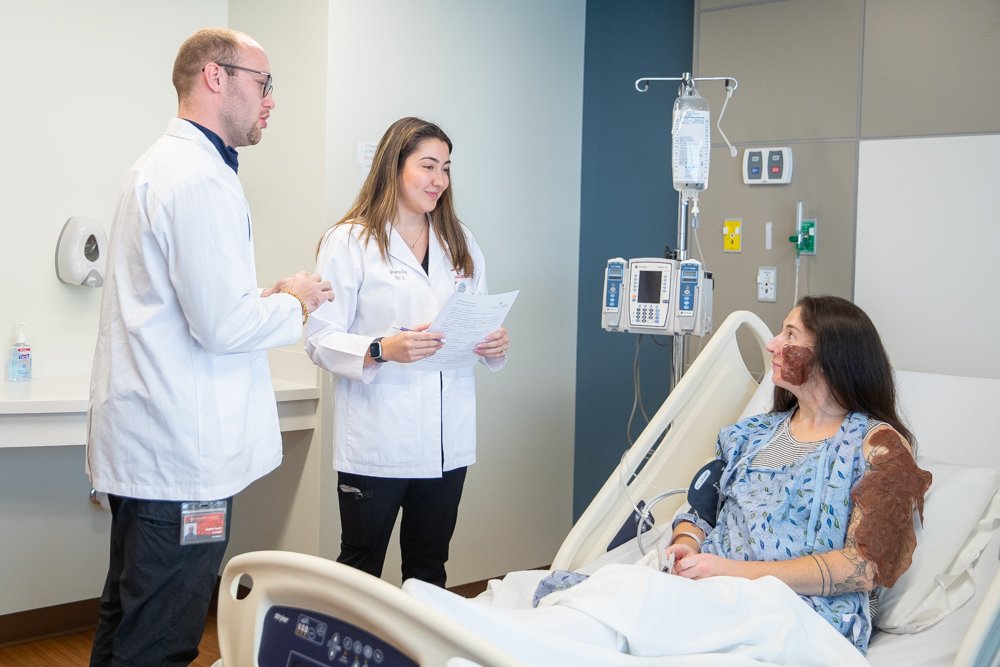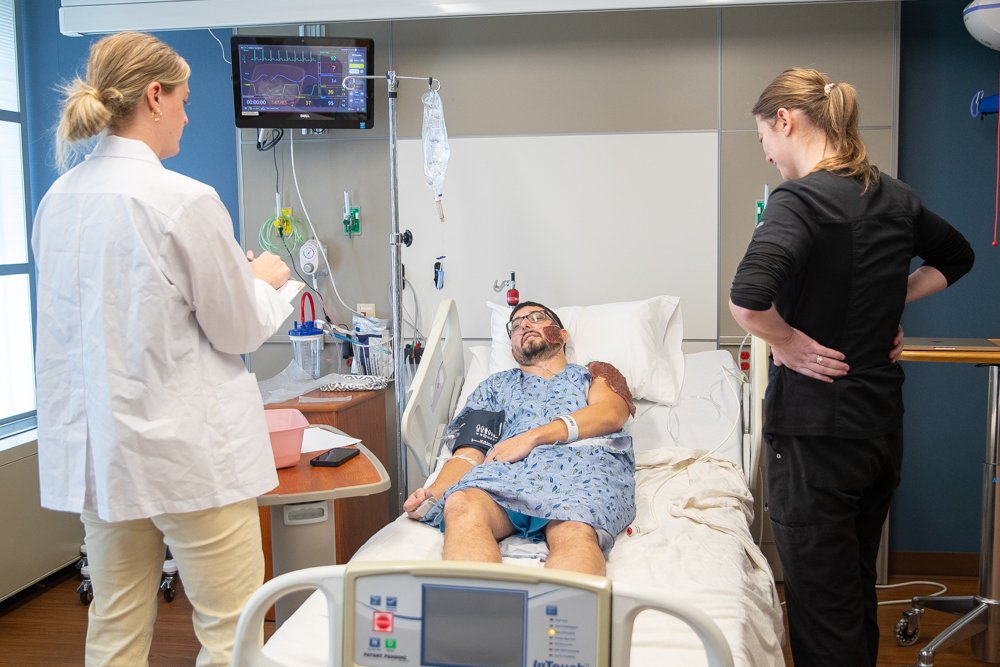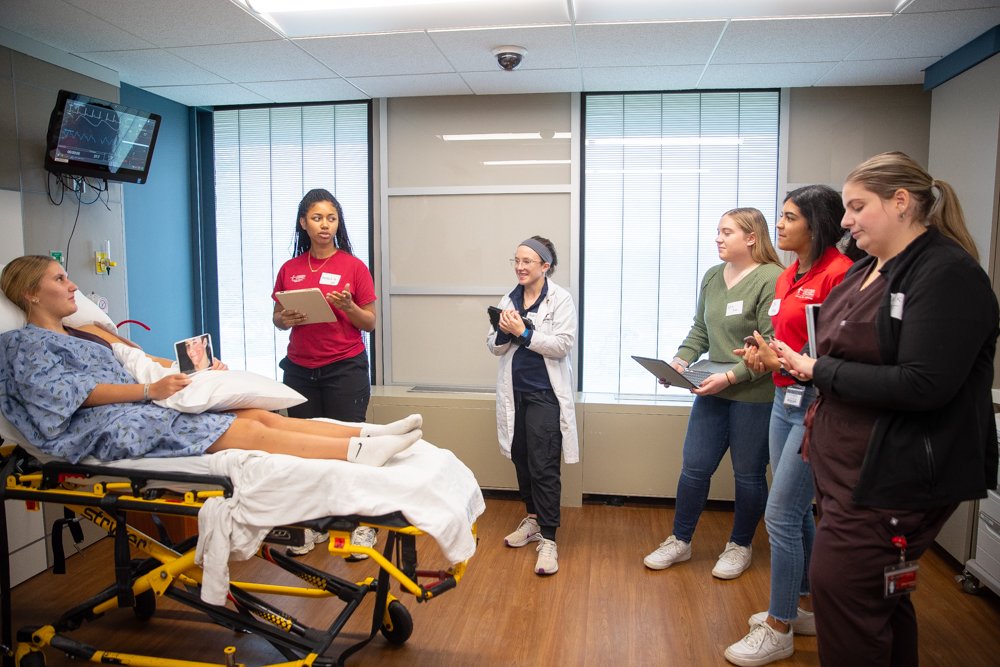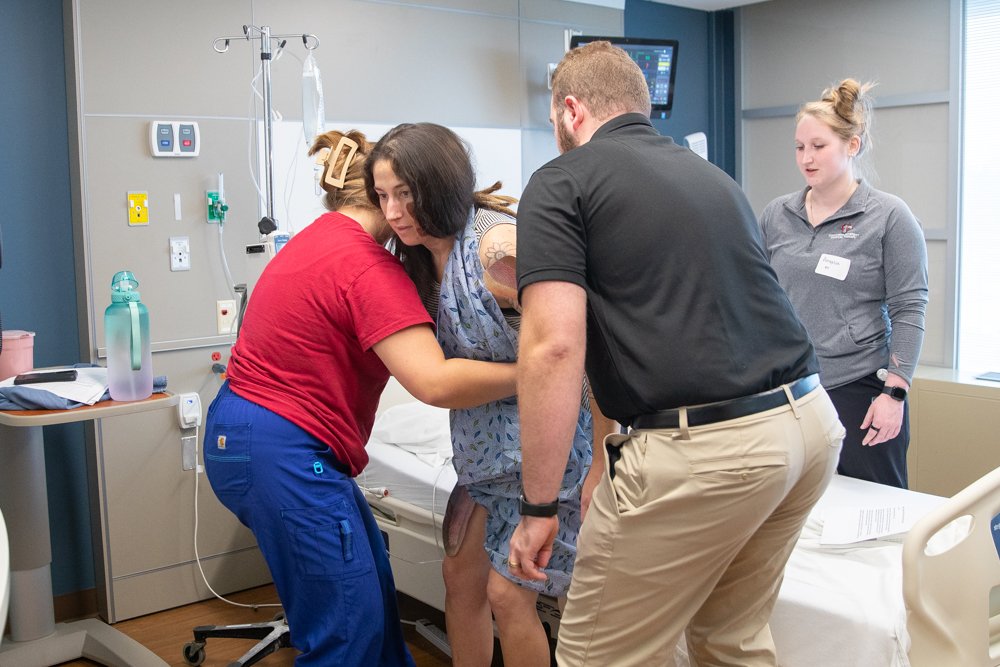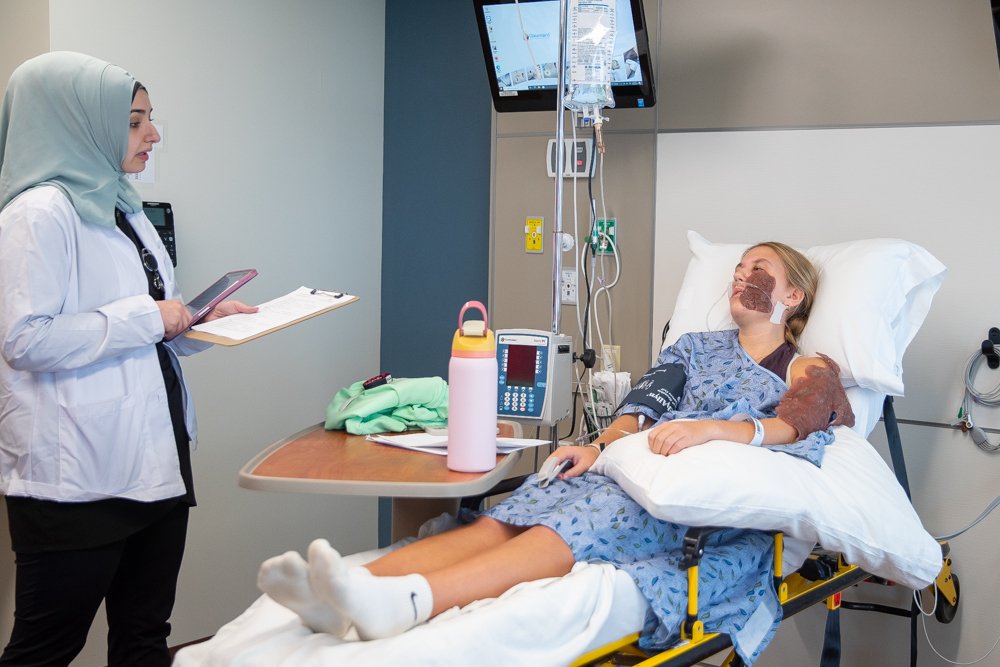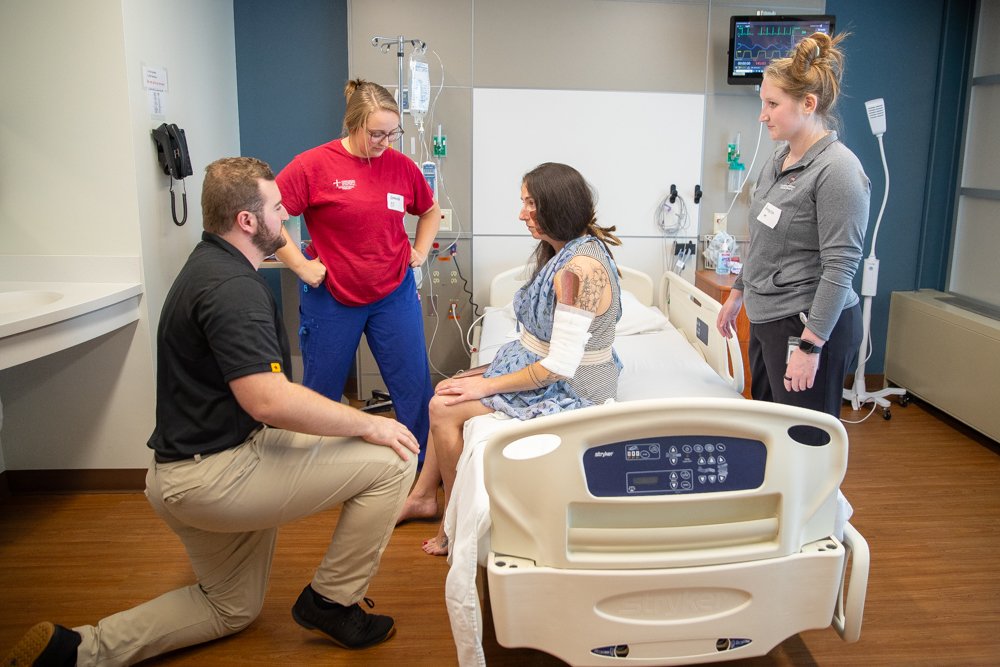
Over 100 students from five healthcare disciplines participated in an IPE simulation event, working together on a complex burn injury scenario to build their teamwork and patient care skills.
Editor’s note: Concordia University Ann Arbor will continue to offer programs into 2025 and beyond. In-person offerings include a variety of nursing and healthcare programs, while online programs include education and business degrees.
*Content warning: This post contains images that may appear graphic. Please note that these are simulated wounds and scenarios.
At Concordia University Ann Arbor’s latest Interprofessional Education (IPE) event, over 100 students from five health disciplines — physical therapy (PT), physician assistant (PA), occupational therapy (OT), nursing, and social work — came together for a hands-on patient simulation. Interprofessional education is a collaborative learning approach that brings together students from different healthcare disciplines to enhance their teamwork skills and improve patient outcomes. This immersive experience, focused on a burn injury case, allowed students to practice collaborating in real-world hospital scenarios.
Hands-On Learning Through Realistic Patient Care Scenarios
The simulation event is a highly immersive experience designed to give students hands-on practice in a hospital-like setting with a patient recovering from serious injuries. The simulated patient, portrayed by faculty/staff and volunteer actors, suffered third-degree burns on the face and arm after accidentally spilling a pot of boiling water. With over 100 students participating, the event is organized into six identical, concurrent simulations, each involving a group of 16-17 students to ensure each participant can engage directly with the patient and the scenario.
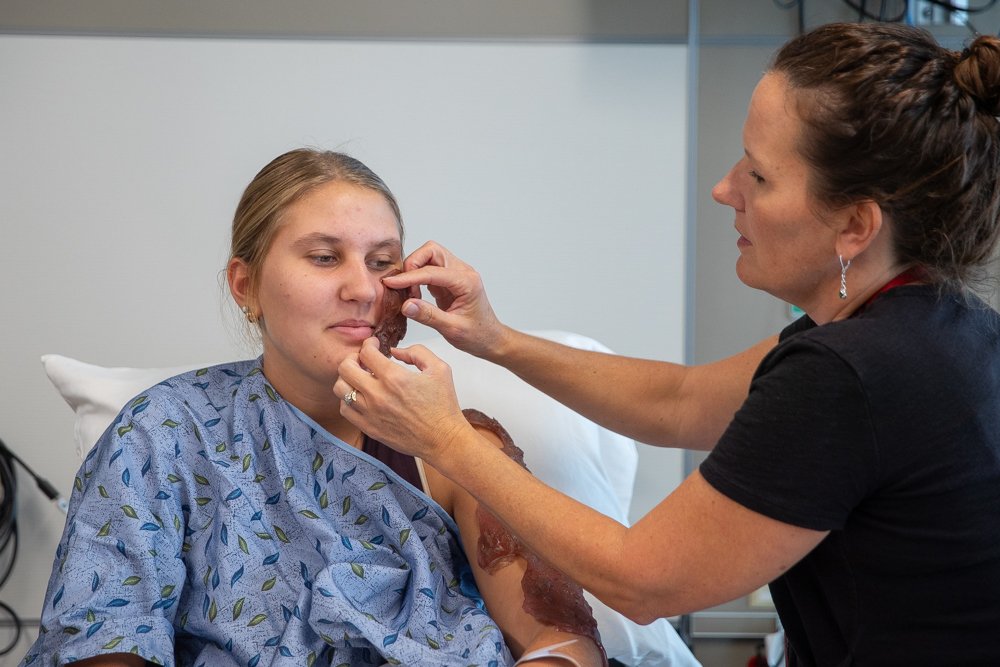
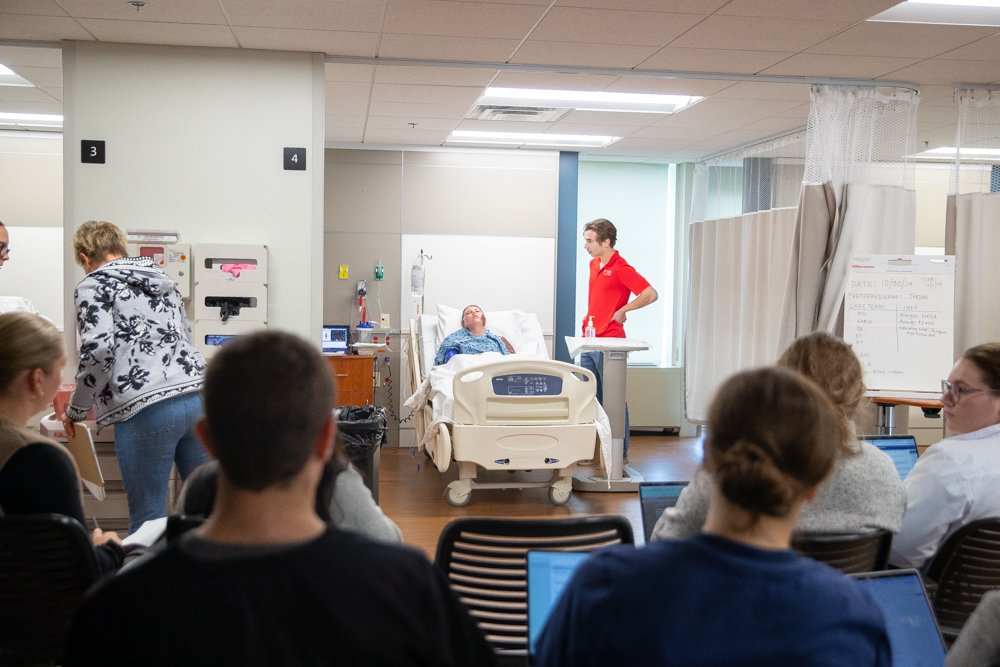
Each group remains intact throughout the event, working together to address the physical, psychological, and emotional needs of the patient. This setup allows students to practice not only medical skills but also to explore the interpersonal and mental health aspects of patient care, which are often overlooked but critical in real-life recovery. Anita Simmons, the Interprofessional Education Coordinator, noted the structured approach: “Our goal is for each student, by the time they graduate, to have participated in four different IPE events. For some students, this is their final one; for others, they have one more to go.”
The simulation is split into three critical scenes, each representing a different phase of the patient’s recovery journey:
- First 24 Hours: Students meet the patient shortly after the accident, managing immediate care needs. This includes pain management, infection risk reduction, and beginning assessments to gauge the severity of the burns. The scene offers students insight into initial physical trauma care and coordination with PT and OT services, who are essential for early movement therapy to prevent stiffness in the shoulder and elbow areas affected by the burns.
- 30 Days After the Accident: As the patient transitions from acute care to rehabilitation, the simulation shifts focus to longer-term physical and emotional challenges. The patient, a college student and athlete on scholarship, expresses concerns about whether they will regain the ability to play their sport and the potential impact on their education if they lose their scholarship. The mental health dimension becomes prominent, with the patient showing signs of depression due to the slow healing process and worries about visible facial disfigurement. Here, social work students join the team to address psychological support and assist with resources for financial and emotional needs, complementing the medical and rehabilitation goals.
- Discharge Meeting: The final scene is an interdisciplinary team meeting preparing the patient for discharge. The patient has questions about at-home care, including follow-up therapies and self-care routines. Students from multiple fields come together to create a comprehensive discharge plan, addressing continued physical needs, PT and OT needs, emotional support, and mental health resources. This scene reinforces the collaborative nature of healthcare, demonstrating to students the importance of clear communication across disciplines to support the patient’s holistic well-being.
According to Simmons, creating this event “is almost like writing a play, but I have a fantastic team with at least one representative from each program and we meet at least monthly to create it” with extensive planning and teamwork required to bring the complex, realistic scenarios to life. The event provides students with an invaluable opportunity to develop empathy and adaptability as they work through the multifaceted recovery process, learning to care for the whole person rather than just the injury.
Learning Together Through Hands-On Collaboration
In the healthcare curriculum for PA, OT, and PT programs, IPE is not just beneficial but required. Each program must demonstrate that students are actively learning to collaborate with other professions. While not mandated for nursing and social work, these programs joined the IPE initiative because of the valuable insights gained from such interdisciplinary teamwork.
The IPE event series has a clear progression, beginning with case study discussions that gradually build each student’s knowledge and confidence before moving into hands-on simulations. “Our goal was to start with case studies and discussions, then move to hands-on simulations where they’re working side by side. It’s learning by doing,” explained Simmons.
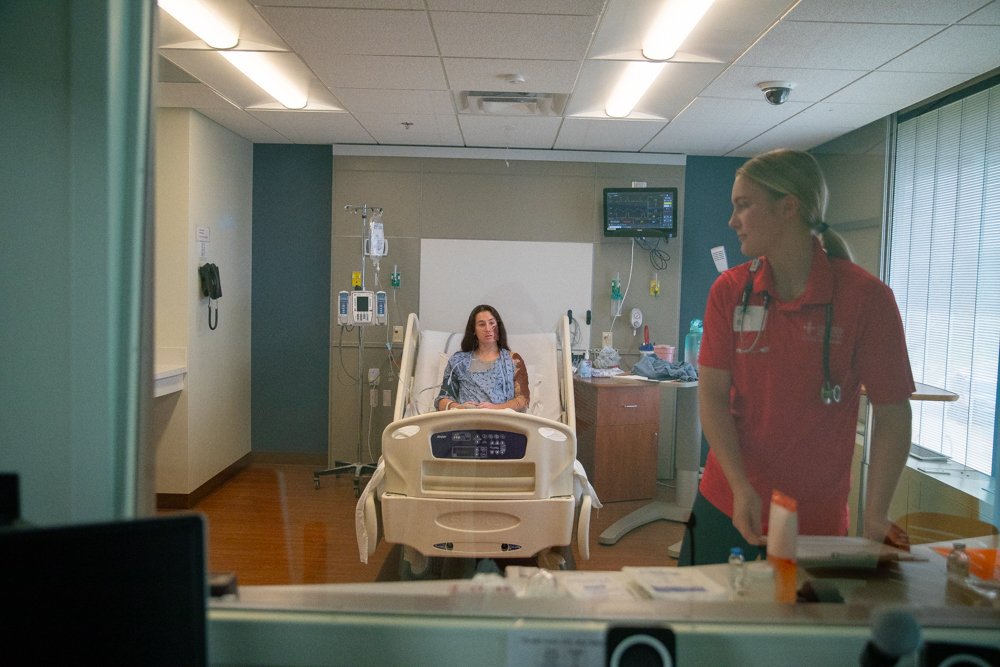
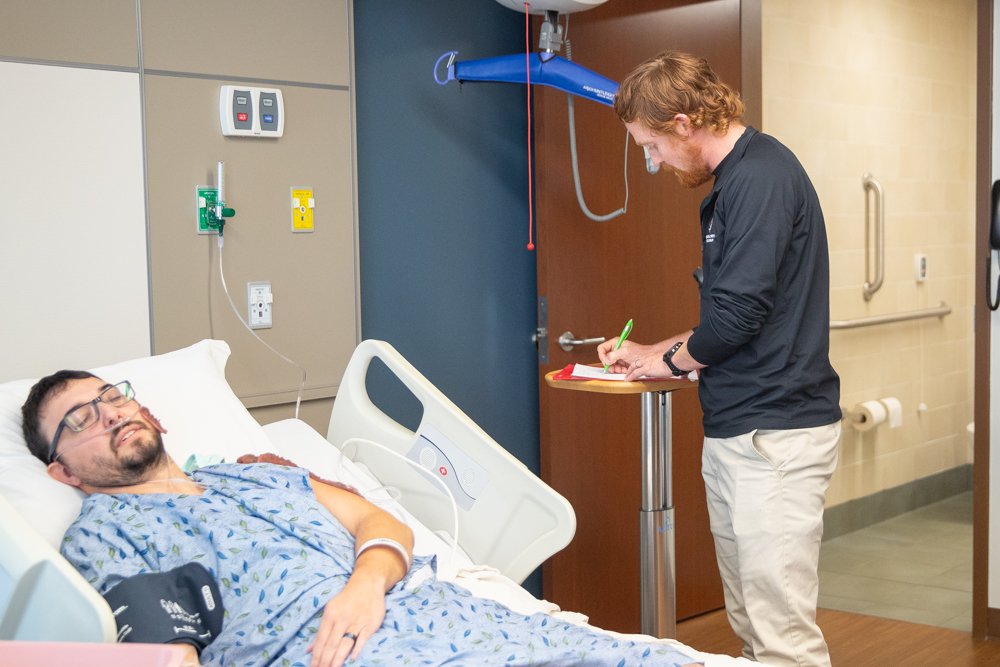
The earlier sessions introduced students to the roles and responsibilities of each profession, but as they’ve participated in multiple events, they’ve gained a deeper understanding of one another’s strengths and approaches to care. Now, they can go a step further: discussing and integrating each unique perspective to provide patients with the highest level of care possible. “The focus is on fostering clear communication across disciplines so that, together, we can achieve the best outcome for the patient,” Simmons added. “By sharing each discipline’s approach, we ensure continuity and alignment in the patient’s recovery and care.”
By collaborating in realistic patient-care simulations, students are now equipped to apply their skills in a way that not only acknowledges but also amplifies each discipline’s contributions, ultimately fostering a more holistic approach to patient care.
Building Professional Skills
Students reflected on how the event shaped their understanding of interprofessional collaboration. Hailey Stasiukinas, a nursing student graduating in May 2025, shared her thoughts: “IPE has been incredible in increasing my interpersonal clinical skills. In school, you don’t often work with other professions, but through IPE events, we get that chance.”
Hailey added that her nursing experience has given her the confidence to advocate for patients more effectively. “As nurses, we spend more one-on-one time with these patients, which helps us prepare for the real world of nursing.”
Caleb Comstock, a PT student graduating in December 2025, echoed these sentiments. “What it does is give students an idea of what other professions do. PA, OT, nursing, even social work — every profession has some overlap, and this makes it easier to work together for the best patient care,” he said. Comstock added, “We were prepared with areas of concern, and it really pushed us to think in the moment about how to address them.”
Preparing Students for Real-World Practice
For many students, this event was a pivotal moment in their professional development. “The presence of faculty facilitators and actors, along with realistic scenarios like specialized burn wound care, truly enhances the experience,” said Simmons. “Our primary goal is to foster effective communication across disciplines to ensure a seamless and cohesive recovery for the patient.” Simmons noted, “I have noticed that during nursing simulations, students are aware of the importance of seeking assistance from other healthcare disciplines. They often say things like, ‘We will go talk to social work,’ or ‘Let’s inform the Physician Assistant about your concern.’ It’s crucial for them to recognize their role and others within the broader healthcare system.” By emphasizing teamwork and communication, the event not only prepared students for real-world practice but also instilled a sense of confidence in their ability to contribute meaningfully to patient care.
Want in?
The School of Health Professions:
The School of Health Professions continues to lead with innovative and impactful programs designed to meet the evolving demands of healthcare, now and into 2025 and beyond. Our program offerings include:
Ronald and Marvel Jones School of Nursing:
At the Ronald and Marvel Jones School of Nursing, we prepare nurses who excel in today’s challenging healthcare landscape, with our program continuing to serve students now and into 2025 and beyond. As a CUAA nursing student, you’ll be equipped to provide compassionate, high-quality care across all ages and settings—from acute care to community outreach. Our dedicated instructors blend rigorous academics with a heart for service, cultivating your professional skills alongside your calling to make a difference. Here, you’ll not only master nursing but also develop a lifelong commitment to impactful, compassionate care.
—This story is written by Keara Chaperon, Social Media Manager for Concordia University Ann Arbor and Concordia University Wisconsin. She may be reached at keara.chaperon@cuaa.edu.
